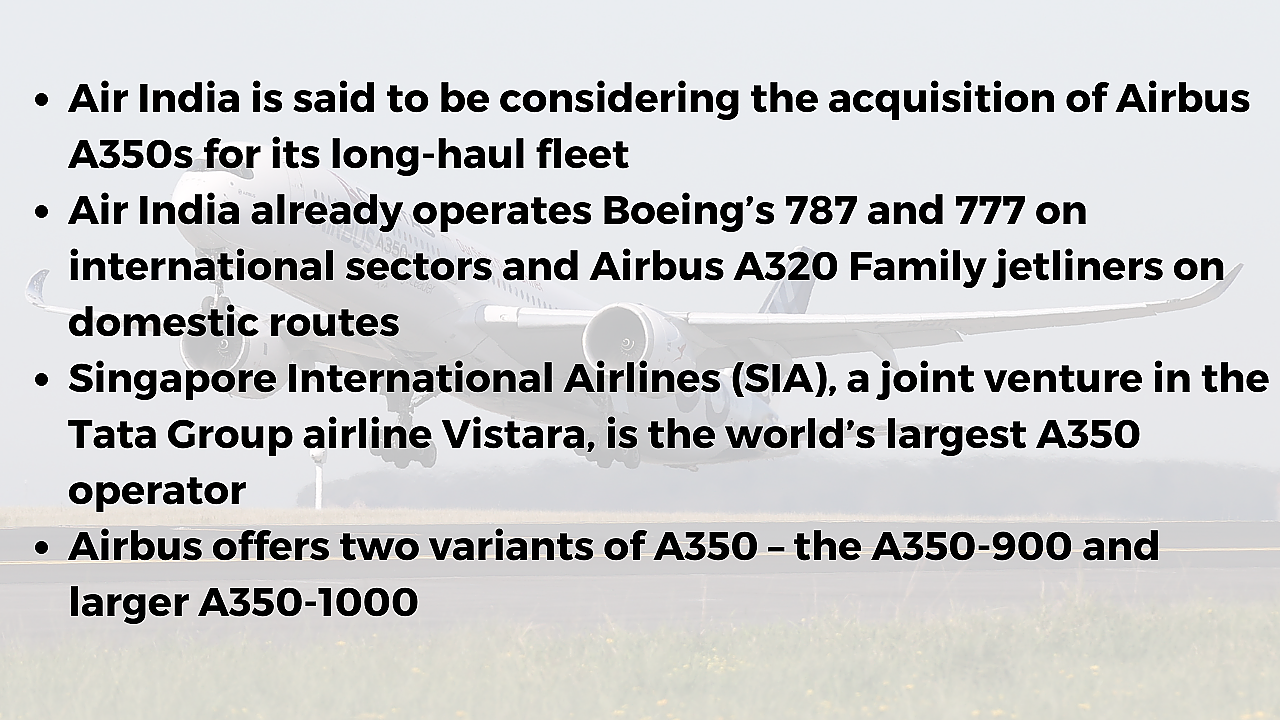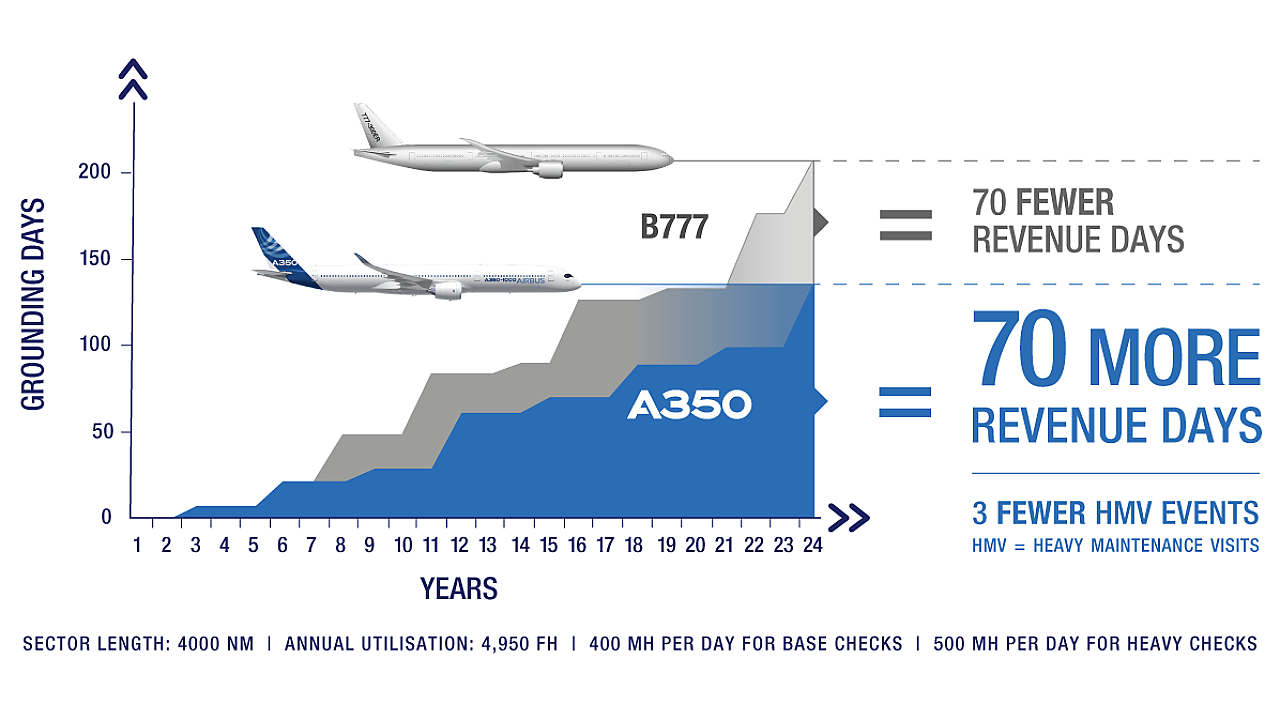
Air India (AI) is considering a widebody jetliner from Airbus with the A350 to meet its long-haul fleet revival needs. A recent report in the Times of India indicated that the airline could place orders for up to 50 A350 jetliners. Worryingly for Boeing, the report indicated that AI is looking to acquire over 100 A320NEO family jetliners.
The PTI report quoted Christian Scherer, Chief Commercial Officer, Airbus, saying, ”Air India is clearly reorganising itself under the very able stewardship of the Tatas, and as such, it is very natural that they contemplate an investment in new fleets, new airplanes, if only to regain more sovereignty, more market share, for an Indian carrier in the international market,” on the sidelines of the annual general meeting of the International Air Transport Association.
Aircraft OEMs and airlines typically wait for major airshows to announce large aircraft orders, and the upcoming Farnborough Airshow (18-22 July) could be the ideal venue for AI to garner publicity with a large aircraft order. An AI order for Airbus widebody jetliners will mark a major shift from the carrier’s historical relationship with US airframer Boeing, which has met its widebody aircraft needs, starting with the B707 in 1960, B747-100s in 1967, followed by deliveries of 747-200 in 1971, 747-300 in 1988 and 747-400 in 1993. In 2005, AI made, at the time, the largest valued single order in commercial aviation history for 68 Boeing aircraft for 27 B787s, 15 B777-300ERs, eight B777-200 LRs and 18 B737-800s. Two of AI’s B777-300ERs have been paid for by the government and are exclusively reserved for VVIP government travel.

Making Inroads
A large order from AI will essentially allow Airbus to all but shut out Boeing from the Indian market. The requirement for single-aisle jetliners dominates the Indian commercial aviation sector, and as such, orders for widebody jetliners are far lower and hence hard fought. The domestic aviation market is dominated by Low-Cost Carriers (LCC) such as IndiGo (A320 Family, ATR), Go Air (A320 Family) and SpiceJet (B737). New Indian carrier Akasa Air has a total of 72 B737 MAXs on order and is to take deliveries of 18 aircraft by March 2023, and the remaining 54 aircraft are to be delivered by 2027. AI already operates A320 Family jetliners, and ATRs on domestic routes, while Air India Express operates an all B737NG fleet.
IndiGo is looking to base its long-haul fleet on the A321NEO family, and if it decided to go for a future widebody type, it would likely to stick with Airbus for reasons of fleet commonality and simplified pilot training. Out of Boeing’s major airline customers, SpiceJet is ailing, while Vistara has been less than enthused by the US airframer’s inability to deliver B787s on order, thus delaying its long-haul growth plans. Boeing halted 787 deliveries over production related issues in May 2021 and continues to perform rework on 787 airplanes in inventory, which forced it to record a $3.5 billion pre-tax non-cash charge on the 787 programme in its Q4 2021 results.

A350XWB
Airbus’ newest widebody jetliner can operate even on ultra-long-haul routes up to 9,700nm, carrying 300-410 passengers in a typical three-class configuration. An A350 can carry up to 480 passengers in a single-class all-economy layout. Airbus offers the aircraft in two versions: the A350-900 and the longer fuselage A350-1000.
Speaking at the Wings India airshow in Hyderabad in March, for which Airbus had an A350 on static display, Rémi Maillard, President and MD of Airbus India & South Asia, said, “The A350 offers the greatest range capability combined with the lowest fuel burn and is the strategic enabler for Indian airlines to regain market share in the lucrative long-haul segment and to grow their operations profitably. We believe the A350 will shape the future of long-range travel.'
The Tata Group shares a strong partnership with Singapore International Airlines Group (SIA Group), which is also a JV partner in Vistara. SIA is the world’s largest A350 operator with over 58 aircraft in service and has also placed orders for seven A350F freighter aircraft.
AI will also need its pilots to be quickly trained on the A350 and could benefit from Airbus’ strong pilot training infrastructure in the region. The Airbus Asia Training Centre (AATC) is the largest Airbus-operated flight crew training centre in the company’s global network, with two A320s, two A330s, one A380 and four A350 simulators. AATC also hosts one ATR 72-600 FFS.
In February, AATC inaugurated its fourth A350 Full Flight Simulator (FFS) in Singapore. “As the world’s largest operator of the Airbus A350, SIA views AATC as a centre of excellence for A350 pilot training. Our strategic partnership continues to grow as the demand for air travel is picking up. AATC’s latest A350 Full Flight Simulator will continue to help SIA and other operators keep pace with the latest training requirements while supporting Singapore's position as a leading aviation hub,” said Captain Quay Chew Eng, Senior Vice President of Flight Operations, Singapore Airlines.
AATC is a joint venture between Airbus and SIA and is part of the Airbus Flight Training Network serving the Asia-Pacific region and beyond. AATC began operations in April 2016 and has successfully attracted 69 airline customers. It can offer type rating and recurrent training courses for up to 10,000 trainees annually.
Innovation Leader
More than 70% of the A350’s airframe uses advanced materials such as composites (up to 54%), titanium, and modern aluminium alloys. Not only did this approach have the benefits of creating a lighter and more efficient aircraft, but it also reduced the effects of corrosion on the airframe, thereby reducing maintenance costs. Compared to the B777-300ER, the A350 has an Operating Weight Empty (OWE) that is 20 tonne lower. The A350-900 and A350-1000 also share a 95% commonality for airframe spares and airframe tooling.

The A350 is powered by two Rolls-Royce Trent XWB turbofan engines and, combined with the aircraft’s 64.75m wing-span and advanced aerodynamics, results in 25% lower fuel burn and CO2 emissions for both A350-900 and A350-1000. Rolls-Royce produces two variants of the Trent XWB for the A350 Family. The Trent XWB–84 powers the A350-900, and the Trent XWB–97 powers the A350-1000. The 1000th Trent XWB–84 engine was delivered by Rolls-Royce in November 2021, and more than 25 million parts were brought together to complete 1000 units of these engines. Each Trent XWB-84 engine requires 6,000 assembly steps before it is completed.
Airbus also introduced its revolutionary Airspace cabin family on the A350, which went on to win two prestigious design awards in 2016. Airbus states that the A350’s cabin is the quietest on a twin-aisle aircraft. The new Airspace cabin provides a feeling of spaciousness with wider seats and high ceilings and uses ambient cabin lighting. Airbus incorporated larger overhead storage compartments, which allowed greater storage for hand luggage (minimum of one roller bag per passenger in all classes). The A350 also incorporates high-bandwidth fibre optics, allowing high-definition video to be offered on all screens of up to 13 inches, even in Economy class.